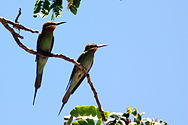| Olive bee-eater | |
|---|---|

| |
| Conservation status | |
 Least Concern (IUCN 3.1) | |
| Scientific classification | |
| Domain: | Eukaryota |
| Kingdom: | Animalia |
| Phylum: | Chordata |
| Class: | Aves |
| Order: | Coraciiformes |
| Family: | Meropidae |
| Genus: | Merops |
| Species: | M. superciliosus |
| Binomial name | |
| Merops superciliosus Linnaeus, 1766 | |
The olive bee-eater or Madagascar bee-eater (Merops superciliosus) is a near passerine bee-eater species in the genus Merops. It is native to the southern half of Africa where it is present in Angola; Botswana; Burundi; Comoros; Democratic Republic of the Congo; Djibouti; Eritrea; Ethiopia; Kenya; Madagascar; Malawi; Mayotte; Mozambique; Namibia; Rwanda; Somalia; South Sudan; Sudan; Tanzania; Uganda; Zambia; Zimbabwe. It is a common species with a wide range so the International Union for Conservation of Nature has rated their conservation status as "least concern".
Taxonomy
In 1760 the French zoologist Mathurin Jacques Brisson included a description of the olive bee-eater in his Ornithologie based on a specimen collected on the island of Madagascar. He used the French name Le guespier de Madagascar and the Latin Apiaster Madagascariensis. Although Brisson coined Latin names, these do not conform to the binomial system and are not recognised by the International Commission on Zoological Nomenclature. When in 1766 the Swedish naturalist Carl Linnaeus updated his Systema Naturae for the twelfth edition, he added 240 species that had been previously described by Brisson. One of these was the olive bee-eater. Linnaeus included a brief description, coined the current binomial name Merops superciliosus and cited Brisson's work. The specific name superciliosus is Latin for "supercilious", "haughty" or "eye-browed".
Two subspecies are recognised:
- M. s. superciliosus Linnaeus, 1766 – east Africa, Madagascar and the Comoro Islands
- M. s. alternans Clancey, 1971 – west Angola and northwest Namibia
Description
The olive bee-eater grows to a length of 23 to 26 cm (9.1 to 10.2 in) with its tail streamers adding up to 7 cm (2.8 in). The sexes are similar, and adults have bronzy-green plumage with an olive cap and white forehead, eyebrows, chin and cheeks. The rump and tail are blue, apart from the streamers, which are black.
Distribution
The olive bee-eater is found in the grassland and coastal mountain forests of East Africa and Madagascar, and an isolated population can be found in coastal Angola. There are two subspecies; M. s. superciliosus occurs in eastern Ethiopia, Somalia and Kenya, and southwards through East Africa to southern Mozambique and the Zambezi Valley, as well as the Comoro Islands and Madagascar; M. s. alternans occurs in western Angola and northwestern Namibia.
Ecology
They are partially migratory, and usually breed only in the southern portion of their range, moving north for the dry season in southern Africa. It lays four eggs in a burrow nest at the beginning of the southern African wet season, and the chicks usually hatch at the beginning of December. Unlike most bee-eaters, the species does not practice cooperative breeding and post-fledging dependence is only around 19 days, which is typical of temperate zone passerines and about half that of most Meropidae species.
Gallery
-
 A bee caught in the Anjajavy Forest
A bee caught in the Anjajavy Forest
-
 Pair in the Anjajavy Forest
Pair in the Anjajavy Forest
-
 In flight over a swimming pool at Anjajavy
In flight over a swimming pool at Anjajavy
References
- ^ BirdLife International (2016). "Merops superciliosus". IUCN Red List of Threatened Species. 2016: e.T22683744A92998077. doi:10.2305/IUCN.UK.2016-3.RLTS.T22683744A92998077.en. Retrieved 12 November 2021.
- Brisson, Mathurin Jacques (1760). Ornithologie, ou, Méthode contenant la division des oiseaux en ordres, sections, genres, especes & leurs variétés (in French and Latin). Vol. 4. Paris: Jean-Baptiste Bauche. pp. 545–549, Plate 42 fig 1. The two stars (**) at the start of the section indicates that Brisson based his description on the examination of a specimen.
- ^ Allen, J.A. (1910). "Collation of Brisson's genera of birds with those of Linnaeus". Bulletin of the American Museum of Natural History. 28: 317–335. hdl:2246/678.
- Linnaeus, Carl (1766). Systema naturae : per regna tria natura, secundum classes, ordines, genera, species, cum characteribus, differentiis, synonymis, locis (in Latin). Vol. 1, Part 1 (12th ed.). Holmiae (Stockholm): Laurentii Salvii. p. 183.
- Jobling, J.A. (2018). del Hoyo, J.; Elliott, A.; Sargatal, J.; Christie, D.A.; de Juana, E. (eds.). "Key to Scientific Names in Ornithology". Handbook of the Birds of the World Alive. Lynx Edicions. Retrieved 6 July 2018.
- Gill, Frank; Donsker, David, eds. (2018). "Todies, motmots, bee-eaters, hoopoes, wood hoopoes, hornbills". World Bird List Version 8.2. International Ornithologists' Union. Retrieved 6 July 2018.
- Fry, C. Hilary; Fry, Kathie (2010). Kingfishers, Bee-eaters and Rollers. Bloomsbury Publishing. p. 273. ISBN 978-1-4081-3525-9.
- "Range map". IUCN. Retrieved 16 October 2016.
- Fry, H.; Boesman, P. (2016). "Olive Bee-eater (Merops superciliosus)". Handbook of the Birds of the World Alive. Lynx Edicions, Barcelona. Retrieved 16 October 2016.
- "Madagascar Bee-eater, Olive Bee-eater". Biodiversity Explorer. Iziko. Retrieved 16 October 2016.
- Langen, Tom A. (2000). "Prolonged offspring dependence and cooperative breeding in birds". Behavioral Ecology. 11 (4): 367–377. doi:10.1093/beheco/11.4.367.
External links
- Olive bee-eater - Species text in The Atlas of Southern African Birds.